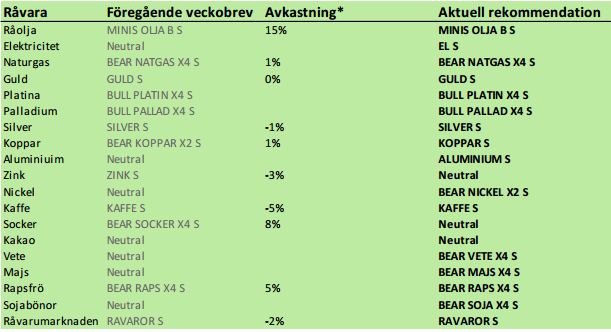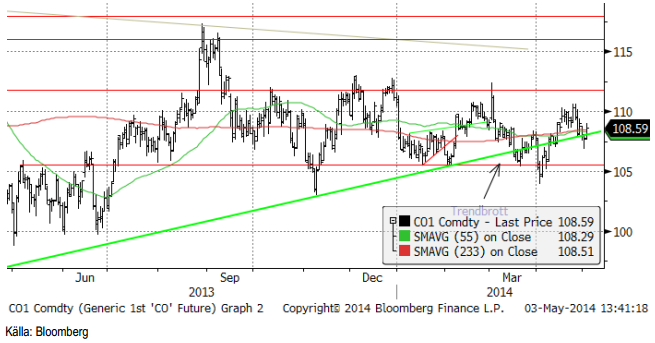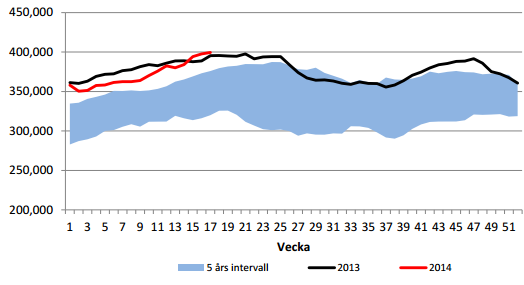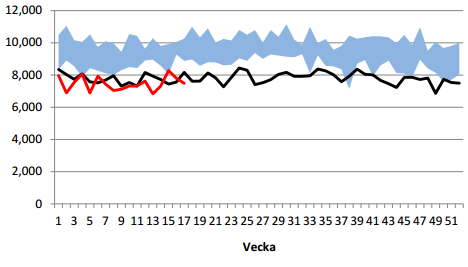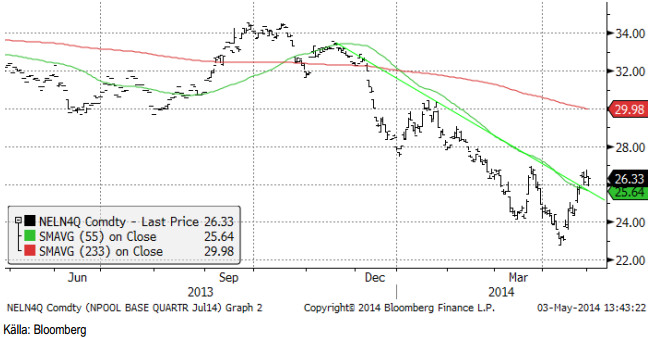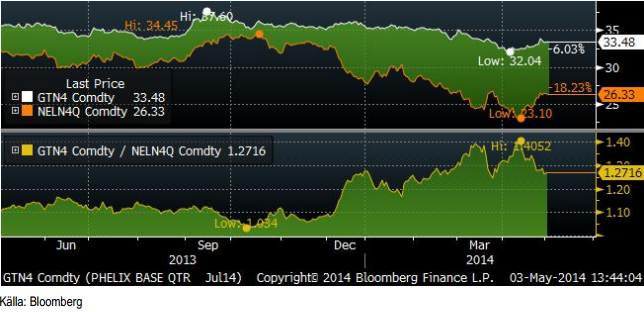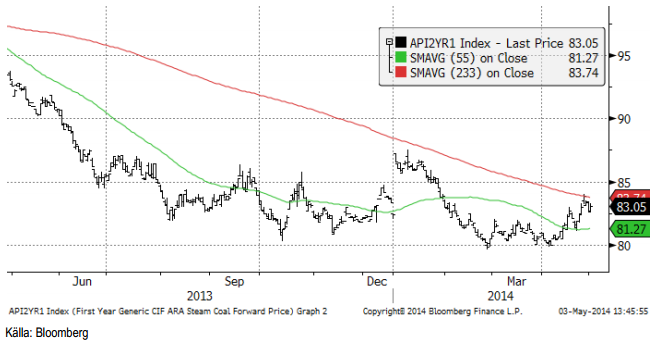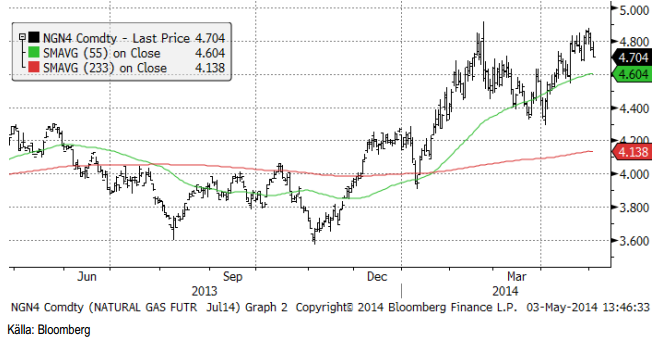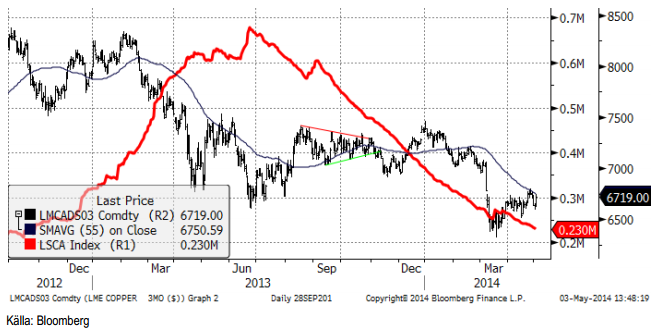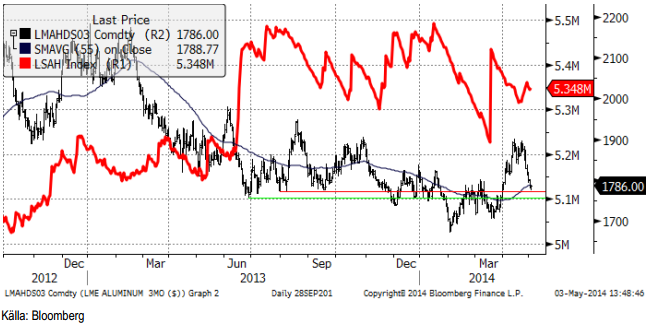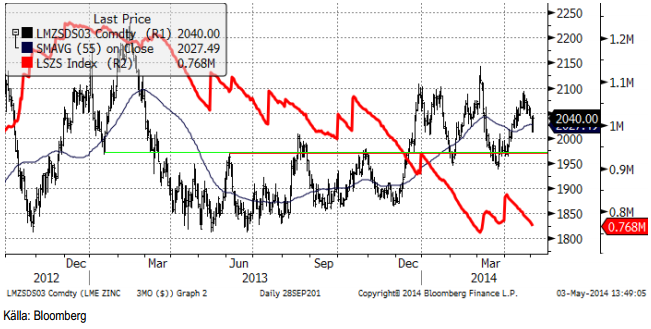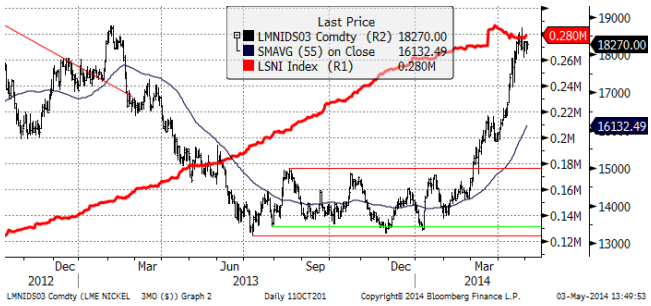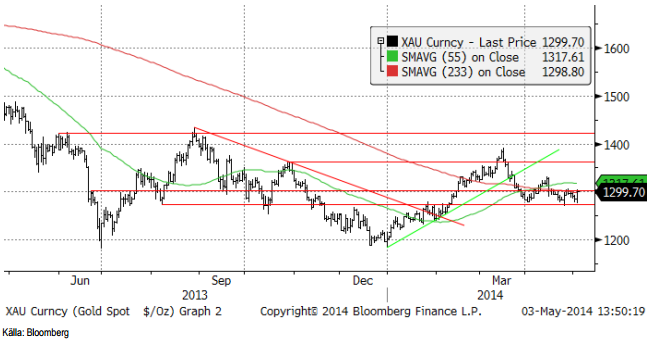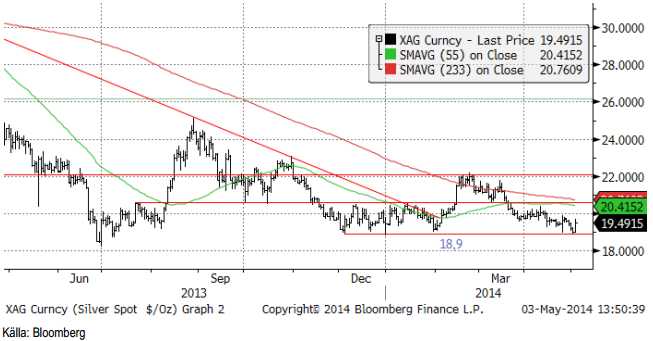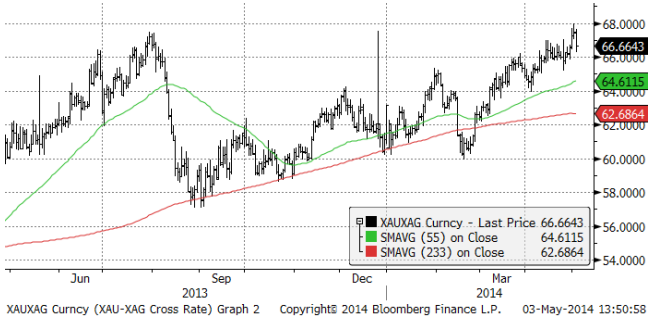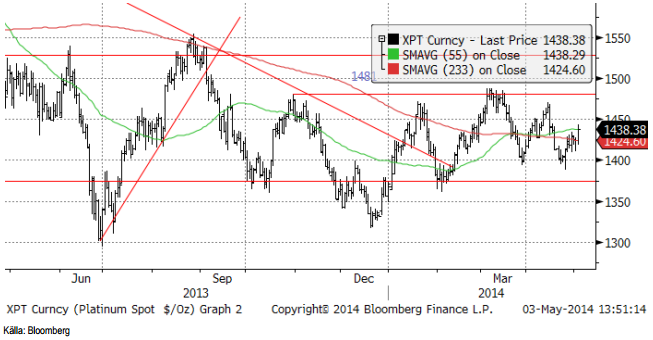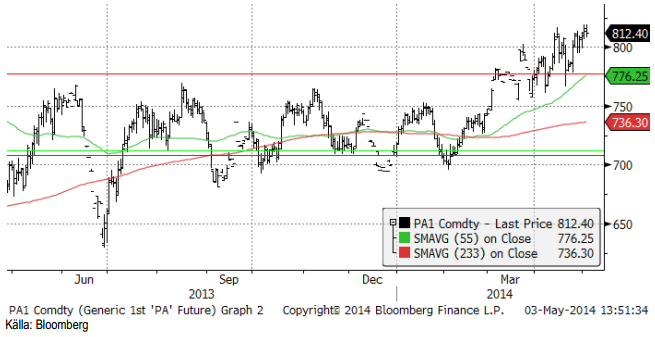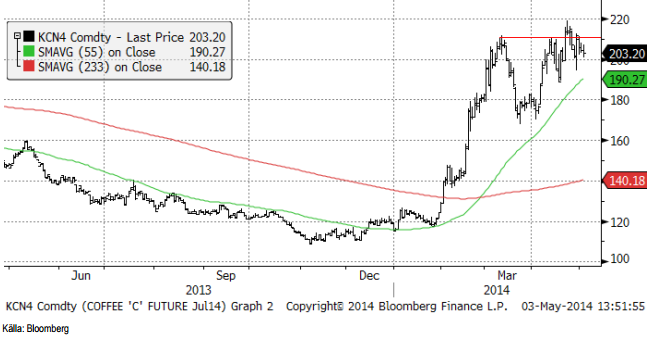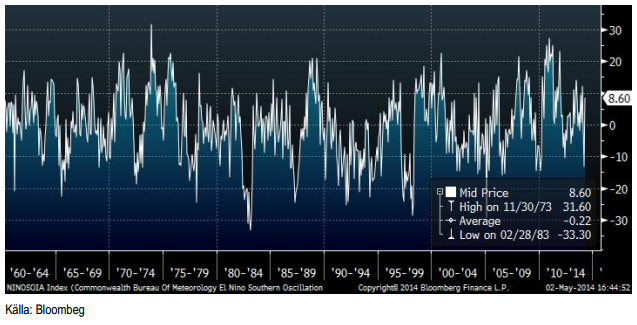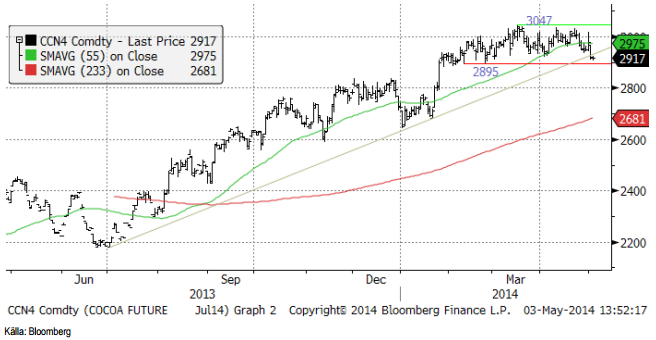Analys
SEB – Råvarukommentarer, 5 maj 2014
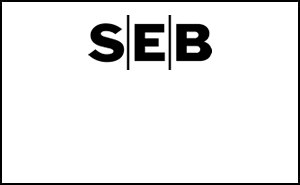
Rekommendationer
Kort sammanfattning
Det är verkligen hög tid att köpa ädelmetaller, trots ”tapering” och bra arbetsmarknadsstatistik i USA. Ädelmetallerna har priser som är i nivå med den genomsnittliga produktionskostnaden och oron i Ukraina, dvs mellan Ryssland och Västvärlden är en faktor som kan driva priset uppåt. Vår rangordning av ädelmetallerna är platina, palladium, silver och guld. De två senare är de som normalt brukar efterfrågas vid geopolitisk oro.
Kopparmarknaden har en liknande situation, med ett pris som är i nivå med produktionskostnaden och dessutom sjunkande lager, som nu hunnit bli ganska låga i ett historiskt perspektiv.
Vetepriset handlades upp i fredags efter förnyad oro för situationen i Ukraina. Däremot ser väderleksprognoserna för alla veteodlande regioner utom Kansas och Texas bättre ut än på flera år. Egyptens GASC köpte också vete från Ukraina och Ryssland, där riskpremien för Ukraina var 1% på priset. Det visar att marknaden för vete fokuserar allt för mycket på Ukrainas problem (vädret och vetet är i perfekt skick) och för lite på vad som faktiskt påverkar marknadens utbud och efterfrågan – och därmed priset. Diskrepansen mellan det pris marknaden har bildat genom fel fokus å ena sidan och jordnära realiteter å den andra, gör att vi rekommenderar sälj på vete. Vädret är gynnsamt för majs också. Sådden i USA är inte sen och som utvecklingen i vädret ter sig nu, kan sådden t o m bli snabbare avklarad än normalt.
Råolja – Brent
Oljepriset föll tillbaka i veckan innan det repade sig till 108.59 vid stängning i fredags. Det är de växlande beskeden från Libyen som marknaden handlar på, bland annat.
Råoljelagren i USA nådde rekordnivå. Lagren vid guldkusten är överfulla pga att produktionen ökat mycket mer än pipelinesystemen byggts ut och raffinaderikapaciteten likaså. Därför har det de senaste månaderna talats om att tillåta export av råolja från USA, men det är bättre ekonomi i att raffinera olja till produkter i USA än att exportera olja t ex till EU för att raffinera den här. I USA finns billig naturgas, som dels kan användas för att uppgradera oljan till lättare kolväten och dels användas som värmekälla i processen.
Importen sjönk från förra veckan; högre import var alltså inte heller den här veckan den drivande faktorn bakom de rekordhöga lagren.
Krisen i Ukraina och Libyens problem innebär två saker. För det första skjuts prisfallet i olja lite på framtiden. För det andra stimuleras spridning av fracking ännu mer, vilket innebär att prisfallet blir ännu djupare när det kommer.
Vi rekommenderar en kort position i olja, t ex med MINIS OLJA B S eller MINIS OLJA A S.
Elektricitet
Elpriset gick i veckan över trendlinjen och vi har då enligt det förra veckobrevet en köprekommendation. Väderleksprognosen enligt GFS-modellen (se nedan under odlingsväder) för de norsk-svenska fjällen ser dock blötare ut än normalt. Om det blir en rekyl nedåt i elpriset kan det vara ett bra tillfälle att gå lång marknaden.
Spreaden mellan Phelix Baseload för det tredje kvartalet och Nasdaqs motsvarande har gått i hop 1% sedan förra veckan, från 28% skillnad till 27% skilllnad. Nordisk el är dock fortfarande ”billig” i förhållande till tysk el.
Priset på kol har rört sig uppåt, men utan större dynamik i rörelsen, varför man kan förvänta sig en rekyl nedåt.
Vi har alltså gått över till köprekommendation, men tycker att man helst ska invänta en rekyl nedåt för att köpa till bättre nivå.
Naturgas
Priset på naturgas har hängt sig kvar vid 4.80 dollar per MMBtu. Att priset inte orkat gå högre än pristoppen i februari, trots ytterligare en veckas försök, får tolkas som ytterligare en negativ signal.
Från USA rapporteras att t ex Marcellusfältet producerar mer naturgas än det finns möjlighet att transportera därifrån via pipelines. Fracking har alltså varit mer framgångsrik än vad logistiken hunnit med att ta hand om. Det är en situation som känns igen från den första oljeruschen i Pennsylvania på 1860-talet och från oljeruschen i Iran, Irak i början av 1900-talet och Saudiarabien vid mitten av 1900-talet. Nyckeln till framgång och förmögenhetsbildning flyttas från den glamorösa oljerushen till den tråkiga pipeline-affären.
Koppar
Det börjar uppmärksammas att lagernivåerna fallit ett längre tag och att trenden håller i sig, trots de ganska låga nivåerna i ett historiskt perspektiv. Ett pris på 6500 dollar per ton är vad det kostar att producera koppar hos Codelco i Chile. Dagens priser är därför förmodligen nära botten.
Vi håller fast vid en köprekommendation på koppar.
Aluminium
Förra veckan hade vi neutral på aluminium. Tekniskt har den fallande trenden brutits, men sedan kom veckans kraftiga rekyl. Lagernivåerna är fortfarande mycket höga och det kommer att ta tid, lång tid, att beta av lagren. Priset är nere på en stödnivå efter veckans ras och det är möjligt att det kan komma en rekyl uppåt från den här nivån. Vi gör därför över till kortsiktigt köp, som rekommendation.
Zink
Zinkpriset har sedan kursrusningen under slutet av förra året, etablerat sig i ett prisintervall med det gamla taket som golv. Golvet finns vid ca 1975 dollar och taket vid 2100 dollar. Den långsiktiga trenden är dock uppåtriktad. Man gör bäst i att försöka köpa certifikat på zink nära golvet på prisintervallet, men generellt sett har vi köprekommendation.
Nickel
Nickelpriset har rusat iväg på ett fenomenalt sätt och nådde för en vecka sedan upp till en gammal toppnivå vid 18500 dollar per ton, senast noterad för drygt ett år sedan. Vi kan inte hitta motiv till en så här stor och snabb prisuppgång, även med hänsyn till Indonesiens exportförbud av obearbetad malm och risken för exportproblem från Ryssland. Vi har haft neutral rekommendation under den senare delen av uppgången och går nu över till säljrekommendation.
Guld
Guldpriset fick stöd av den förnyade oron i Ukraina. Vi kallar det som händer för ”oro”, men det handlar i själva verket om krig mellan Ukraina och Ryssland. Dels har gatudemonstranterna på den pro-ryska sidan toppmoderna versioner av AK-47 och dels har de inte bara knölpåkar utan även luftvärnsmissilsystem och kunskap att skjuta träffsäkert med dem. Årsdagen av Rysslands seger i det andra världskriget infaller i veckan som kommer, vilket kan öka entusiasmen från den sidan. Det kan och borde ge guldmarknaden en ökad lyster.
Vi rekommenderar köp av GULD S.
Silver
Silverpriset fann som väntat stöd på 18.9 dollar per finuns. Eftersom silverpriset är lågt i en historisk jämförelse med guldpriset, föredrar vi silver framför guld.
Nedan ser vi ett diagram över priset på guld uttryckt i silver. Det går alltså över 66 finuns silver på varje fin-uns av guld. Som vi ser är det en hög nivå, dvs silver är billigt i förhållande till guld.
Vi anser att silver är mer köpvärt än guld och skulle vilja köpa på de här nivåerna. Vi rekommenderar köp av SILVER S.
Platina & Palladium
Platina påverkades också av ”oroligheterna” i Ukraina, liksom guld och silver. Till platinas fördel talar också den omöjliga situationen i Sydafrika. Gruvbolagen går inte runt och gruvarbetarna vill ha mer betalt. Det kan bara sluta med att det kommer att produceras mindre platina till ett högre pris. Någon annan utgång finns inte.
Den mycket inflytelserika analysfirman GFMS, som nuförtiden är en del av Reuters, publicerade sin årsvisa Platinum and Palladium Survey i fredags. Rapportens innehåll återspeglar samma sak jag sagt länge i det här veckobrevet – lite drygt hälften av gruvorna går med vinst. En stor del gör det inte. Det är inte en långsiktigt hållbar marknadsbalans. Produktionen måste ner. Därmed kommer priset att stiga.
Priset på palladium har också fortsatt att sega sig uppåt. Arbetsmarknadsstatistiken från USA i fredags var oväntat positiv. Fler personer i sysselsättning innebär sannolikt fler bilar och därmed mer palladium i katalysatorer, totalt sett.
Vi rekommenderar köp av PLATINA S och PALLADIUM S, eller BULL PLATINA X4 S eller BULL PALLAD X4 S.
För den som vill ta ännu mer risk, finns nu även BULL PALLAD X5 S.
Kaffe
Ur teknisk synvinkel ser kaffemarknaden ut att ha gått in i en konsolieeringsfas, eller en toppformation. För att behålla den stigande pristrenden måste marknaden ta ut toppen på 220 cent per pund. Det ser marknaden inte ut att vara i begrepp att göra.
När allt fokus har varit på torkan i Brasilien har en ny fara för global kaffeproduktion dykt upp. El Niño väntas slå till i juli och enligt sex av sju klimatmodeller väntas den växa i styrka under hösten. På norra halvklotet börjar skörden av kaffe i september och oktober. El Niño skapar torka i länder som Australien, Indonesien och Vietnamn. De två senare är stora producenter av robusta-kaffe. Nedan ser vi hur Southern Oscillation Index har utvecklat sig sedan 1960. Ett SOI > 8.5 innebär La Niña och SOI < -8.5 innebär El Niño.
Vi tar dessa noteringar och identifierar när det varit torka före skörd i Indonesien och testar statistiskt för effekten på Indonesiens kaffeproduktion dessa år. Jag väljer Indonesien istället för Vietnam, världens största producent, eftersom Vietnams kaffeproduktion blommade ut ganska sent, efter Vietnamnkrigets slut 1975. Indonesien har haft en ganska stabil produktion.
En statistiskt körning visar att Indonesiens produktion minskar med nästan 5% när det varit El Niño och det estimatet är nästan statistiskt signifikant på 5% nivån. I vart fall tillräckligt för att vi ska ta det som helt säkert att det kommer att bli en mindre produktion i år. Detta var alltså Indonesien, men det ser säkerligen likadant ut för Vietnam.
5% mindre produktion av robusta, utöver ett produktionsbortfall på ca 20% från Brasilien bör ha en ytterligare prisdrivande effekt på marknadspriset, även om det rent tekniskt inte ser så ut just nu.
Vi rekommenderar köp av KAFFE S, men man bör ta stoppen om kaffepriset går under 200 cent.
Kakao
Priset på kakao ligger i ett etablerat prisintervall med botten på 2895 och tak på 3047. Dynamiken verkar vara på nedsidan i prisrörelserna, men i fredags fick marknaden stöd när priset var nära botten på prisintervallet. Vi fortsätter med neutral vy till dess golvet vid 2895 inte bryts.
[box]SEB Veckobrev Veckans råvarukommentar är producerat av SEB Merchant Banking och publiceras i samarbete och med tillstånd på Råvarumarknaden.se[/box]
Disclaimer
The information in this document has been compiled by SEB Merchant Banking, a division within Skandinaviska Enskilda Banken AB (publ) (“SEB”).
Opinions contained in this report represent the bank’s present opinion only and are subject to change without notice. All information contained in this report has been compiled in good faith from sources believed to be reliable. However, no representation or warranty, expressed or implied, is made with respect to the completeness or accuracy of its contents and the information is not to be relied upon as authoritative. Anyone considering taking actions based upon the content of this document is urged to base his or her investment decisions upon such investigations as he or she deems necessary. This document is being provided as information only, and no specific actions are being solicited as a result of it; to the extent permitted by law, no liability whatsoever is accepted for any direct or consequential loss arising from use of this document or its contents.
About SEB
SEB is a public company incorporated in Stockholm, Sweden, with limited liability. It is a participant at major Nordic and other European Regulated Markets and Multilateral Trading Facilities (as well as some non-European equivalent markets) for trading in financial instruments, such as markets operated by NASDAQ OMX, NYSE Euronext, London Stock Exchange, Deutsche Börse, Swiss Exchanges, Turquoise and Chi-X. SEB is authorized and regulated by Finansinspektionen in Sweden; it is authorized and subject to limited regulation by the Financial Services Authority for the conduct of designated investment business in the UK, and is subject to the provisions of relevant regulators in all other jurisdictions where SEB conducts operations. SEB Merchant Banking. All rights reserved.
Analys
Tightening fundamentals – bullish inventories from DOE

The latest weekly report from the US DOE showed a substantial drawdown across key petroleum categories, adding more upside potential to the fundamental picture.

Commercial crude inventories (excl. SPR) fell by 5.8 million barrels, bringing total inventories down to 415.1 million barrels. Now sitting 11% below the five-year seasonal norm and placed in the lowest 2015-2022 range (see picture below).
Product inventories also tightened further last week. Gasoline inventories declined by 2.1 million barrels, with reductions seen in both finished gasoline and blending components. Current gasoline levels are about 3% below the five-year average for this time of year.
Among products, the most notable move came in diesel, where inventories dropped by almost 4.1 million barrels, deepening the deficit to around 20% below seasonal norms – continuing to underscore the persistent supply tightness in diesel markets.
The only area of inventory growth was in propane/propylene, which posted a significant 5.1-million-barrel build and now stands 9% above the five-year average.
Total commercial petroleum inventories (crude plus refined products) declined by 4.2 million barrels on the week, reinforcing the overall tightening of US crude and products.


Analys
Bombs to ”ceasefire” in hours – Brent below $70

A classic case of “buy the rumor, sell the news” played out in oil markets, as Brent crude has dropped sharply – down nearly USD 10 per barrel since yesterday evening – following Iran’s retaliatory strike on a U.S. air base in Qatar. The immediate reaction was: “That was it?” The strike followed a carefully calibrated, non-escalatory playbook, avoiding direct threats to energy infrastructure or disruption of shipping through the Strait of Hormuz – thus calming worst-case fears.

After Monday morning’s sharp spike to USD 81.4 per barrel, triggered by the U.S. bombing of Iranian nuclear facilities, oil prices drifted sideways in anticipation of a potential Iranian response. That response came with advance warning and caused limited physical damage. Early this morning, both the U.S. President and Iranian state media announced a ceasefire, effectively placing a lid on the immediate conflict risk – at least for now.
As a result, Brent crude has now fallen by a total of USD 12 from Monday’s peak, currently trading around USD 69 per barrel.
Looking beyond geopolitics, the market will now shift its focus to the upcoming OPEC+ meeting in early July. Saudi Arabia’s decision to increase output earlier this year – despite falling prices – has drawn renewed attention considering recent developments. Some suggest this was a response to U.S. pressure to offset potential Iranian supply losses.
However, consensus is that the move was driven more by internal OPEC+ dynamics. After years of curbing production to support prices, Riyadh had grown frustrated with quota-busting by several members (notably Kazakhstan). With Saudi Arabia cutting up to 2 million barrels per day – roughly 2% of global supply – returns were diminishing, and the risk of losing market share was rising. The production increase is widely seen as an effort to reassert leadership and restore discipline within the group.
That said, the FT recently stated that, the Saudis remain wary of past missteps. In 2018, Riyadh ramped up output at Trump’s request ahead of Iran sanctions, only to see prices collapse when the U.S. granted broad waivers – triggering oversupply. Officials have reportedly made it clear they don’t intend to repeat that mistake.
The recent visit by President Trump to Saudi Arabia, which included agreements on AI, defense, and nuclear cooperation, suggests a broader strategic alignment. This has fueled speculation about a quiet “pump-for-politics” deal behind recent production moves.
Looking ahead, oil prices have now retraced the entire rally sparked by the June 13 Israel–Iran escalation. This retreat provides more political and policy space for both the U.S. and Saudi Arabia. Specifically, it makes it easier for Riyadh to scale back its three recent production hikes of 411,000 barrels each, potentially returning to more moderate increases of 137,000 barrels for August and September.
In short: with no major loss of Iranian supply to the market, OPEC+ – led by Saudi Arabia – no longer needs to compensate for a disruption that hasn’t materialized, especially not to please the U.S. at the cost of its own market strategy. As the Saudis themselves have signaled, they are unlikely to repeat previous mistakes.
Conclusion: With Brent now in the high USD 60s, buying oil looks fundamentally justified. The geopolitical premium has deflated, but tensions between Israel and Iran remain unresolved – and the risk of missteps and renewed escalation still lingers. In fact, even this morning, reports have emerged of renewed missile fire despite the declared “truce.” The path forward may be calmer – but it is far from stable.
Analys
A muted price reaction. Market looks relaxed, but it is still on edge waiting for what Iran will do

Brent crossed the 80-line this morning but quickly fell back assigning limited probability for Iran choosing to close the Strait of Hormuz. Brent traded in a range of USD 70.56 – 79.04/b last week as the market fluctuated between ”Iran wants a deal” and ”US is about to attack Iran”. At the end of the week though, Donald Trump managed to convince markets (and probably also Iran) that he would make a decision within two weeks. I.e. no imminent attack. Previously when when he has talked about ”making a decision within two weeks” he has often ended up doing nothing in the end. The oil market relaxed as a result and the week ended at USD 77.01/b which is just USD 6/b above the year to date average of USD 71/b.

Brent jumped to USD 81.4/b this morning, the highest since mid-January, but then quickly fell back to a current price of USD 78.2/b which is only up 1.5% versus the close on Friday. As such the market is pricing a fairly low probability that Iran will actually close the Strait of Hormuz. Probably because it will hurt Iranian oil exports as well as the global oil market.
It was however all smoke and mirrors. Deception. The US attacked Iran on Saturday. The attack involved 125 warplanes, submarines and surface warships and 14 bunker buster bombs were dropped on Iranian nuclear sites including Fordow, Natanz and Isfahan. In response the Iranian Parliament voted in support of closing the Strait of Hormuz where some 17 mb of crude and products is transported to the global market every day plus significant volumes of LNG. This is however merely an advise to the Supreme leader Ayatollah Ali Khamenei and the Supreme National Security Council which sits with the final and actual decision.
No supply of oil is lost yet. It is about the risk of Iran closing the Strait of Hormuz or not. So far not a single drop of oil supply has been lost to the global market. The price at the moment is all about the assessed risk of loss of supply. Will Iran choose to choke of the Strait of Hormuz or not? That is the big question. It would be painful for US consumers, for Donald Trump’s voter base, for the global economy but also for Iran and its population which relies on oil exports and income from selling oil out of that Strait as well. As such it is not a no-brainer choice for Iran to close the Strait for oil exports. And looking at the il price this morning it is clear that the oil market doesn’t assign a very high probability of it happening. It is however probably well within the capability of Iran to close the Strait off with rockets, mines, air-drones and possibly sea-drones. Just look at how Ukraine has been able to control and damage the Russian Black Sea fleet.
What to do about the highly enriched uranium which has gone missing? While the US and Israel can celebrate their destruction of Iranian nuclear facilities they are also scratching their heads over what to do with the lost Iranian nuclear material. Iran had 408 kg of highly enriched uranium (IAEA). Almost weapons grade. Enough for some 10 nuclear warheads. It seems to have been transported out of Fordow before the attack this weekend.
The market is still on edge. USD 80-something/b seems sensible while we wait. The oil market reaction to this weekend’s events is very muted so far. The market is still on edge awaiting what Iran will do. Because Iran will do something. But what and when? An oil price of 80-something seems like a sensible level until something do happen.
-

 Nyheter3 veckor sedan
Nyheter3 veckor sedanStor uppsida i Lappland Guldprospekterings aktie enligt analys
-

 Nyheter4 veckor sedan
Nyheter4 veckor sedanBrookfield ska bygga ett AI-datacenter på hela 750 MW i Strängnäs
-

 Nyheter3 veckor sedan
Nyheter3 veckor sedanSilverpriset släpar efter guldets utveckling, har mer uppsida
-

 Nyheter4 veckor sedan
Nyheter4 veckor sedanTradingfirman XTX Markets bygger datacenter i finska Kajana för 1 miljard euro
-

 Nyheter2 veckor sedan
Nyheter2 veckor sedanUppgången i oljepriset planade ut under helgen
-

 Nyheter2 veckor sedan
Nyheter2 veckor sedanLåga elpriser i sommar – men mellersta Sverige får en ökning
-

 Analys2 veckor sedan
Analys2 veckor sedanVery relaxed at USD 75/b. Risk barometer will likely fluctuate to higher levels with Brent into the 80ies or higher coming 2-3 weeks
-

 Nyheter1 vecka sedan
Nyheter1 vecka sedanMahvie Minerals växlar spår – satsar fullt ut på guld


